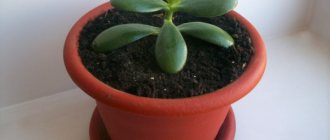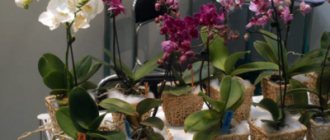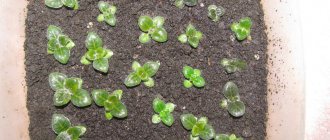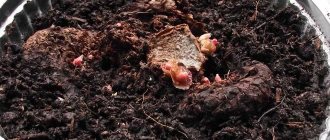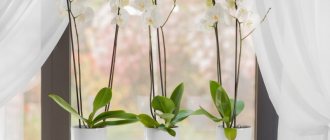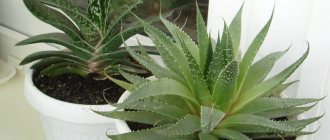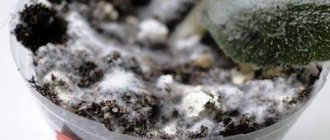Requirements for flower containers that must be met
Orchids belong to the category of plants in which the root system is involved in photosynthesis. Therefore, the penetration of sunlight through the walls of the container is of great importance. The container for epiphytes must be transparent.
The right pot must meet several more requirements:
- Given the natural growth conditions, the plant does not require a large container. It should be slightly larger than the root system.
- The container should provide good aeration of the roots and unimpeded drainage of excess moisture. To do this, there should be several holes at the bottom.
- The plant requires maintaining a certain temperature regime, so it is preferable to use plastic pots.
The right container for an orchid creates favorable conditions for the plant - as close as possible to its natural habitat.
The correct choice of container affects the well-being of the flower in the next few years, so you need to follow some rules.
Correct for common domestic species
Phalaenopsis is the most common type of flower that can be kept at home. This epiphyte will feel comfortable both in standard containers, the height of which is greater than the width, and in bowls with an open root system. The main condition is a large number of drainage holes and transparency.
Read more about which container to choose for phalaenopsis here.
For dendrobiums you need to choose small containers. The volume of the pot should correspond to the volume of the root system.
Cattleyas, on the contrary, need spacious containers with a wide neck - baskets or bowls.
Cymbidium roots grow vertically downwards, so the plant needs tall transparent pots with drainage holes. Otherwise, the development of the root system will be limited to the bottom of the container.
Should it be transparent or not?
A transparent pot is required only for phalaenopsis; the roots of this variety take part in photosynthesis. Other species can grow in containers of any color.
This container will be useful for beginning gardeners. Through the walls you can monitor the condition of the roots and control the need for watering.
Why and what is not suitable?
There are several options for containers, the use of which is strictly contraindicated for orchids of any kind.
It is not recommended to use:
- containers without ventilation holes on the sides and drainage holes at the bottom;
- metal;
- unstable or with a narrow neck.
When is the best time to plant a plant?
When transplanting an orchid into a new container, you have to manipulate the root system - remove damaged and dead areas.
Root regeneration requires favorable conditions, so it is recommended to consider the following information:
- During the resting phase, strength accumulates before active growth begins.
- During flowering, all energy is spent on the peduncle and flowers.
- After flowering, the plant is weakened and needs rest.
It turns out that spring is best. The plant has already gained strength and entered the active growth phase.
Reference! The exception is the detection of pests in the container. In this case, at any time of the year, you should urgently get rid of them, treat the roots and change the substrate.
Options with photos
The range of products for gardeners offers a large number of different containers for growing. Before purchasing, you need to figure out which option will be most suitable for planting a certain type of plant.
Plastic
The most common and affordable type of pot. The orchid roots do not stick to the walls, sunlight penetrates well into the root system, and thanks to the transparency of the vessel, you can monitor the health of the roots. The unpresentable appearance is the only disadvantage of such a container. Suitable for all types of plants.
Glass vase for closed system
Orchids in a glass vase or flask look especially impressive and will be an excellent gift for any occasion. However, such a container is suitable only for those varieties that allow growth without soil (in or without water). Vandas and phalaenopsis are grown in this way.
It is not recommended to place a flower in a glass vessel on a windowsill or refrigerator to prevent excessive hypothermia.
Read more about how to grow crops without soil in this article.
Crown with holes
The design of such a container is designed specifically to meet the needs of capricious orchids. It consists of a small tray and rods extending from it, through which air circulates. Well suited for phalaenopsis and vandas.
The gaps between the rods are both plus and minus at the same time. The substrate will be washed out through these holes during operation. In addition, the container system will not retain moisture inside; it will quickly evaporate through the walls. You will have to water the flower more often. Also, “Crown” containers are more expensive than regular ones.
Double
Consists of two containers. The internal one is equipped with a large number of drainage holes and a footrest for the accumulation of liquid.
A double pot for orchids includes an automatic watering system. In such containers, it is necessary to constantly ensure that the liquid in the pan does not stagnate, otherwise this will lead to rotting of the roots. Flower growers have fallen in love with the double, inexpensive containers from Fiji.
Clay
Unfired clay retains and distributes moisture well in the root system. The substrate in such a pot dries out and does not rot. The containers have an impressive mass and are stable. The rough surface of the vessel is noted as a disadvantage. The roots will stick to the walls.
Dendrobiums, oncidiums, brassias and cattleyas grow well in clay containers.
Ceramic
An orchid in a ceramic pot looks aesthetically pleasing. The roots breathe well, so they require frequent watering. The inner surface is smooth, so the roots do not grow.
Wooden hanging basket on the wall
Pots made from natural materials are characterized by good air exchange and lightness.
The porous structure of the walls ensures good ventilation of the root system. Moisture evaporates quickly, so the orchid needs to be watered more often. Externally, such baskets look very aesthetically pleasing and are a beneficial addition to the plant. Thanks to the hanging design, it can be placed anywhere. Great for Vandas and Cattleyas.
Large and ideal for several plants
Paired orchids will be a wonderful addition to the interior; as a rule, two different varieties are used. Plants are planted in a single container or in one that has two special compartments.
Preference should be given to containers that are not deep and wide.
Special with automatic watering
The auto-watering function greatly simplifies the procedure for caring for the plant. This option will be especially relevant for flower growers who are often absent from home.
You can purchase a container with automatic watering at any flower shop. But you can design such a container yourself. The most popular option is a pot with a tray.
Bamboo
Bamboo containers are pots made from bamboo rods. Their composition brings the conditions for keeping orchids in the natural environment as close as possible.
The mesh design of the container provides good ventilation, which promotes uniform drying of the substrate.
Bamboo pots, as a rule, are not small in volume and are intended for growing large varieties.
Backlit
In conditions of lack of natural light, you can support the normal development and health of the flower using a backlit pot. Such models will be effective in autumn and winter. This design can be used as a night light. The only negative is the high cost.
An alternative to such a container would be to install artificial lighting. Read how to do this here.
Why do you need to replant orchids?
Replanting any plant is stressful, after which the flower may even get sick. In this regard, the orchid is no exception, so the procedure is carried out only when certain signs appear.
Reasons for replanting a flower are:
- The appearance of algae and moss on the walls of the pot. This signals that the substrate has compacted, large pieces of bark have separated and crumbled. Sphagnum does not function as a moisture storage facility, which can lead to root rot.
- The substrate is covered with a white coating from too hard water or excess fertilizer, and therefore needs to be replaced.
- The roots grew so much that they pushed large fractions of the substrate out of the pot. A larger pot is required.
- The leaves have become lethargic and do not restore tugor after watering. The problem is rotting roots.
- Dark, moldy or dried roots can be seen through the walls of the pot. Wet, healthy roots have a green tint, dry ones are golden.
- The orchid turns easily in the pot. This may be due to drying out roots.
- Pests spotted inside the pot.
In any of these cases, you need to remove the phalaenopsis from the flowerpot, clean and treat the root system, and change the substrate.
Reference! The appearance of aerial adventitious roots from the substrate is not a signal for replanting a flower. This indicates that the orchid is healthy and developing well.
Handmade
You can make a container for an orchid with your own hands. The main thing is to adhere to the basic requirements for pots. The material used is plastic or wood.
A plastic container is the simplest and most affordable option. You need to follow a few simple steps:
- take a plastic container as a basis: a bottle, bucket, etc., which can be purchased at a disposable tableware store;
- using a soldering iron or a heated nail, make many drainage holes on the bottom and sides;
- The pot for the plant is ready.
The video shows a manufacturing option:
How to replant a flower at home?
Orchid transplantation consists of several stages. Before work you should prepare:
- disinfected pruning shears or garden shears;
- crushed wood, activated carbon or antiseptic;
- boiled or fried expanded clay for drainage;
- substrate;
- new pot.
The procedure is performed in the following sequence:
- The plant is removed from the old container, being careful not to damage the fragile roots. To do this, the plastic pot is slightly squeezed from different sides. In other cases, lightly pat the sides. If it is not possible to remove the roots from the drainage holes, you have to sacrifice the flowerpot. The plastic is cut, the remaining materials are broken.
- The root ball is thoroughly washed in running water.
- Using scissors, cut off dried and rotten roots to healthy tissue. The cut areas are treated with an antiseptic or sprinkled with charcoal.
- Carefully inspect the roots for pests. When they are detected, the roots are placed in warm water for several hours, then treated with insecticides (Fitoverm, Fitosporin).
- The root system is dried at room temperature for 8-10 hours.
- Yellowed, dried leaves are completely cut off, and the sections are disinfected.
- 3-5 cm of drainage is poured onto the bottom of the disinfected pot, and a small layer of substrate is placed on top.
- The sympodial orchid is placed closer to the wall, the monopodial is lowered into the center of the pot. The roots are distributed evenly over the entire surface. If necessary, install a support for the peduncle nearby.
- The free space is filled with substrate. Large pieces of bark are placed at the bottom, medium ones in the middle, and small ones on top. The bark is carefully pushed between the roots with a cotton swab.
- Periodically pat the walls of the pot with your palm to smooth out the substrate. Tamping is unacceptable; fragile roots can be damaged.
- A layer of sphagnum is placed on top of the substrate, protecting it from rapid evaporation of moisture.
Attention! Aerial roots do not need to be immersed in the substrate. They must stay outside.
Soil: which is better?
They strive to make the composition of soil for orchids as close as possible to the tropical natural conditions of plant growth. The substrate should be light and loose.
The soil can be single-component and consist only of pine bark or multi-component, additionally including expanded clay, moss, coal, expanded clay, peat, coconut fibers, perlite, vermiculite, fern roots and charcoal.
How often should I transplant?
A purchased orchid is not always contained in a high-quality substrate. If the plant looks healthy, there is no reason to touch it. The flower is left in the shipping container until next year. If, instead of a substrate, pieces of compressed moss or foam rubber are found, replanting even a flowering plant is carried out urgently. Delay can lead to rotting of the root collar or roots.
The orchid is sensitive to changes in the environment, and subsequent adaptation may take a long time. In the absence of signs of root disease, the planned procedure is carried out no more than once every 3 years.
How will the orchid grow in a new pot?
The transplanted plant must adapt to the new environment. For this, phalaenopsis needs conditions different from standard ones. If you follow them, the root system will quickly fill the free space of the new flowerpot and enter its normal life mode. This can be determined by the revived ground part.
Care after transplant
Replanting an orchid is stressful. Experienced flower growers advise following the following rules for caring for a transplanted flower:
- The flower pot is placed in a place protected from the sun and drafts.
- the average temperature should be 20-22°C;
- in the first 3-4 days the plant is not watered, only the moss is sprayed;
- The pot should not be moved unless absolutely necessary.
The orchid is kept in a shaded place for 8-10 days. During spraying, make sure that water does not accumulate in the axils of the leaves.
Watering
Depending on the temperature and humidity in the room, the first watering is done on days 4-8. Until the flower has taken root, it is better to give it a warm shower. After watering, be sure to dry the rosette and leaves. At this time, it is better not to top up than to overfill.
After about 3 weeks, watering begins in the usual way:
- the pot with the orchid is lowered into warm water;
- the bark is held down so that it does not float up and become saturated with moisture;
- after 5 minutes, remove the pot and allow the water to drain completely;
- return the plant to its original place.


